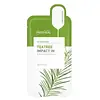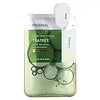What's inside
What's inside
 Key Ingredients
Key Ingredients

 Benefits
Benefits

 Concerns
Concerns

 Ingredients Side-by-side
Ingredients Side-by-side

Water
Skin Conditioning1,2-Hexanediol
Skin ConditioningSodium Hyaluronate
HumectantGlycereth-25 PCA Isostearate
EmulsifyingGlyceryl Glucoside
HumectantEthylhexylglycerin
Skin ConditioningCaprylyl Glycol
EmollientAdenosine
Skin ConditioningPhormium Tenax Leaf Water
AntioxidantDisodium EDTA
Lactobacillus Ferment
Skin ConditioningPolyquaternium-51
Skin ConditioningAllantoin
Skin ConditioningMelaleuca Alternifolia Leaf Extract
PerfumingMelaleuca Alternifolia Leaf Oil
AntioxidantGlycerin
HumectantButylene Glycol
HumectantGlucose
HumectantHinokitiol
Panthenol
Skin ConditioningBifida Polysaccharide
HumectantUlmus Davidiana Root Extract
Skin ConditioningXanthan Gum
EmulsifyingMadecassoside
AntioxidantBeta-Glucan
Skin ConditioningDextrin
AbsorbentAsiaticoside
AntioxidantChondrus Crispus Extract
Skin ConditioningZeolite
AbsorbentHydroxypropyltrimonium Hyaluronate
Sodium Acetylated Hyaluronate
HumectantHydrolyzed Hyaluronic Acid
HumectantHyaluronic Acid
HumectantSodium Hyaluronate Crosspolymer
HumectantHydrolyzed Sodium Hyaluronate
Skin ConditioningPotassium Hyaluronate
Skin ConditioningWater, 1,2-Hexanediol, Sodium Hyaluronate, Glycereth-25 PCA Isostearate, Glyceryl Glucoside, Ethylhexylglycerin, Caprylyl Glycol, Adenosine, Phormium Tenax Leaf Water, Disodium EDTA, Lactobacillus Ferment, Polyquaternium-51, Allantoin, Melaleuca Alternifolia Leaf Extract, Melaleuca Alternifolia Leaf Oil, Glycerin, Butylene Glycol, Glucose, Hinokitiol, Panthenol, Bifida Polysaccharide, Ulmus Davidiana Root Extract, Xanthan Gum, Madecassoside, Beta-Glucan, Dextrin, Asiaticoside, Chondrus Crispus Extract, Zeolite, Hydroxypropyltrimonium Hyaluronate, Sodium Acetylated Hyaluronate, Hydrolyzed Hyaluronic Acid, Hyaluronic Acid, Sodium Hyaluronate Crosspolymer, Hydrolyzed Sodium Hyaluronate, Potassium Hyaluronate
Water
Skin ConditioningButylene Glycol
HumectantGlycerin
HumectantChondrus Crispus Powder
AbrasiveCeratonia Siliqua Gum
Emollient1,2-Hexanediol
Skin ConditioningCyamopsis Tetragonoloba Gum
Emulsion StabilisingAgar
MaskingHydroxyacetophenone
AntioxidantGlucose
HumectantChlorphenesin
AntimicrobialPotassium Chloride
Glycereth-25 PCA Isostearate
EmulsifyingAllantoin
Skin ConditioningXanthan Gum
EmulsifyingHydroxyethylcellulose
Emulsion StabilisingEthylhexylglycerin
Skin ConditioningSodium Hyaluronate
HumectantCaprylyl Glycol
EmollientCentella Asiatica Extract
CleansingDisodium EDTA
Lactobacillus Ferment
Skin ConditioningMelaleuca Alternifolia Leaf Water
AntimicrobialErythritol
HumectantXylitol
HumectantBetula Platyphylla Japonica Juice
Skin ConditioningMelaleuca Alternifolia Leaf Oil
AntioxidantPentylene Glycol
Skin ConditioningMadecassoside
AntioxidantPortulaca Oleracea Extract
Skin ConditioningHouttuynia Cordata Extract
Skin ConditioningTocopherol
AntioxidantWater, Butylene Glycol, Glycerin, Chondrus Crispus Powder, Ceratonia Siliqua Gum, 1,2-Hexanediol, Cyamopsis Tetragonoloba Gum, Agar, Hydroxyacetophenone, Glucose, Chlorphenesin, Potassium Chloride, Glycereth-25 PCA Isostearate, Allantoin, Xanthan Gum, Hydroxyethylcellulose, Ethylhexylglycerin, Sodium Hyaluronate, Caprylyl Glycol, Centella Asiatica Extract, Disodium EDTA, Lactobacillus Ferment, Melaleuca Alternifolia Leaf Water, Erythritol, Xylitol, Betula Platyphylla Japonica Juice, Melaleuca Alternifolia Leaf Oil, Pentylene Glycol, Madecassoside, Portulaca Oleracea Extract, Houttuynia Cordata Extract, Tocopherol
Ingredients Explained
These ingredients are found in both products.
Ingredients higher up in an ingredient list are typically present in a larger amount.
1,2-Hexanediol is a synthetic liquid and another multi-functional powerhouse.
It is a:
- Humectant, drawing moisture into the skin
- Emollient, helping to soften skin
- Solvent, dispersing and stabilizing formulas
- Preservative booster, enhancing the antimicrobial activity of other preservatives
Allantoin is a soothing ingredient known for its protective and moisturizingg properties. Because of this, it is often added to products with strong active ingredients.
Studies show higher concentrations of this ingredient can promote wound healing.
Though it can be derived from the comfrey plant, allantoin is produced synthetically for cosmetic products to ensure purity.
Learn more about AllantoinButylene Glycol (or BG) is used within cosmetic products for a few different reasons:
Overall, Butylene Glycol is a safe and well-rounded ingredient that works well with other ingredients.
Though this ingredient works well with most skin types, some people with sensitive skin may experience a reaction such as allergic rashes, closed comedones, or itchiness.
Learn more about Butylene GlycolCaprylyl Glycol is a humectant and emollient, meaning it attracts and preserves moisture.
It is a common ingredient in many products, especially those designed to hydrate skin. The primary benefits are retaining moisture, skin softening, and promoting a healthy skin barrier.
Though Caprylyl Glycol is an alcohol derived from fatty acids, it is not the kind that can dry out skin.
This ingredient is also used as a preservative to extend the life of products. It has slight antimicrobial properties.
Learn more about Caprylyl GlycolDisodium EDTA plays a role in making products more stable by aiding other preservatives.
It is a chelating agent, meaning it neutralizes metal ions that may be found in a product.
Disodium EDTA is a salt of edetic acid and is found to be safe in cosmetic ingredients.
Learn more about Disodium EDTAEthylhexylglycerin (we can't pronounce this either) is commonly used as a preservative and skin softener. It is derived from glyceryl.
You might see Ethylhexylglycerin often paired with other preservatives such as phenoxyethanol. Ethylhexylglycerin has been found to increase the effectiveness of these other preservatives.
Glucose is a simple sugar and is the most important source of energy in all organisms.
In skincare, glucose is used to hydrate the skin. It also acts as a prebiotic for our natural biome.
Glucose is hydrating due to its humectant property. As a humectant, glucose draws moisture from the air and from deeper levels in the skin.
Our skin contains many sugars that act as prebiotics and help strengthen our natural microbiome. Having a healthy microbiome helps protect our skin from harmful bacteria and other contaminants.
Studies show glucose may help with fading discoloration and pigmentation. This is because our skin metabolizes glucose into lactic acid. Lactic acid is an AHA that helps exfoliate the top layer of skin.
Learn more about GlucoseGlycereth-25 PCA Isostearate isn't fungal acne safe.
Glycerin is already naturally found in your skin. It helps moisturize and protect your skin.
A study from 2016 found glycerin to be more effective as a humectant than AHAs and hyaluronic acid.
As a humectant, it helps the skin stay hydrated by pulling moisture to your skin. The low molecular weight of glycerin allows it to pull moisture into the deeper layers of your skin.
Hydrated skin improves your skin barrier; Your skin barrier helps protect against irritants and bacteria.
Glycerin has also been found to have antimicrobial and antiviral properties. Due to these properties, glycerin is often used in wound and burn treatments.
In cosmetics, glycerin is usually derived from plants such as soybean or palm. However, it can also be sourced from animals, such as tallow or animal fat.
This ingredient is organic, colorless, odorless, and non-toxic.
Glycerin is the name for this ingredient in American English. British English uses Glycerol/Glycerine.
Learn more about GlycerinLactobacillus Ferment is created by fermenting the Lactobacillus bacteria. It helps keep our skin's natural barrier and microbiome healthy.
Studies show lactobacillus ferment to be effective at repairing the skin barrier. Having a healthy skin barrier helps keep your skin healthy and hydrated. It also protects against bad bacteria.
As a probiotic/prebiotic/postbiotic, Lactobacillus ferment can help regular our natural biome. In fact, one study found a lack of diversity in our natural skin biome can trigger acne.
Learn more about Lactobacillus FermentMadecassoside comes from the super popular skin-soothing ingredient, Centella asiatica. It is one of four active compounds found in the extract of Centella Asiatica.
Madecassoside has antioxidant, anti-inflammatory, and hydrating properties. It contains fatty acids, amino acids, beta-carotene, and phytochemicals.
One study found using Madecassoside with ascorbic acid helped reduce the signs of aging and improved skin hydration.
Learn more about MadecassosideThis tea tree oil comes from the leaves of the Tea Tree plant. Tea tree oil has antioxidant, anti-inflammatory, and antimicrobial properties.
According to the book Journal of Profiles of Drug Substances, tea tree helps in reducing acne-causing bacteria such as Propionibacterium acnes. This is due to the Terpinen components of tea tree oil.
Tea tree may cause sensitivity and irritation for some people. This oil naturally contains fragrance such as linalool and limonene.
However, research shows irritation usually occurs when using pure tea tree oil and not in cosmetic products.
Tea tree oil was found to help relieve the symptoms of psoriasis in one study.
Tea tree oil is toxic when ingested. Another study showed it to caused damage to the nervous system of dogs and cats when applied to their skin or given orally.
Learn more about Melaleuca Alternifolia Leaf OilSodium Hyaluronate is hyaluronic acid's salt form. It is commonly derived from the sodium salt of hyaluronic acid.
Like hyaluronic acid, it is great at holding water and acts as a humectant. This makes it a great skin hydrating ingredient.
Sodium Hyaluronate is naturally occurring in our bodies and is mostly found in eye fluid and joints.
These are some other common types of Hyaluronic Acid:
Learn more about Sodium HyaluronateWater. It's the most common cosmetic ingredient of all. You'll usually see it at the top of ingredient lists, meaning that it makes up the largest part of the product.
So why is it so popular? Water most often acts as a solvent - this means that it helps dissolve other ingredients into the formulation.
You'll also recognize water as that liquid we all need to stay alive. If you see this, drink a glass of water. Stay hydrated!
Learn more about WaterXanthan gum is used as a stabilizer and thickener within cosmetic products. It helps give products a sticky, thick feeling - preventing them from being too runny.
On the technical side of things, xanthan gum is a polysaccharide - a combination consisting of multiple sugar molecules bonded together.
Xanthan gum is a pretty common and great ingredient. It is a natural, non-toxic, non-irritating ingredient that is also commonly used in food products.
Learn more about Xanthan Gum